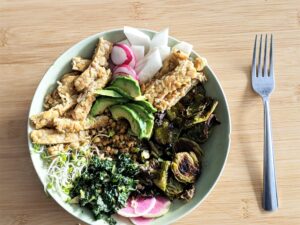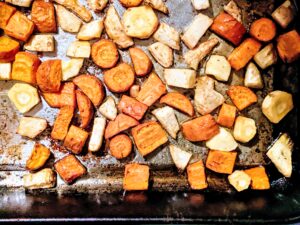BY DEBRA KEEFER RAMAGE

Healthy grain bowl
Oh, great. Not only is it winter, but it’s in the peak of a terrible pandemic. And you want to talk about wellness? Is that some kind of sick joke? When the conditions are most stacked against your goal, that’s not when you give up, it’s when you sharpen your game. Especially if your game is literally staying alive, and keeping your near and dear ones safe as well.
Most of the tips here for winter wellness have nothing to do with the pandemic, specifically. Many of these tips help prevent colds, flu, digestive problems or aching muscles. Some will protect against depression, poor balance, cognitive decline, degenerative diseases, lack of energy, headaches or heart ailments. And if they also lessen your chances of catching COVID-19, or protect you from the worst ravages if you do catch it, so much the better. Let us break down the art for you.
Food
A famous Ayurvedic proverb says it best: “When diet is wrong, medicine is of no use. When diet is correct, medicine is of no need.” And by diet, I—and the Ayurvedic sages—don’t mean some artificial composition like “paleo” or “low fat.” We just mean “everything that you eat.” That’s your diet.
That being said, many traditions of healthy eating, both ancient and modern, have prescriptions. Nowadays we can (at some expense) do sophisticated testing to see how each person’s body system respond to various foods.
In general, eat what is local to where you live, what is in season, what is traditional with your own people. But also try things that are traditional to other people and see how they affect you. Don’t eat anything you can’t pronounce or don’t know (at least theoretically) how to produce if you had to.
Many of the trendiest foods in restaurants and spas are ridiculously easy to make for yourself. Rice bowls, which can be based on any grain, not just rice, are an example. No special equipment required. Here’s one to try: facebook.com/deborama/posts/10159077187806204.
Citrus juices are very low-tech to make. For more high-tech juices, such as apple, pear, celery, greens and so on, a juicer will make them achievable, and lacking that, it may be possible with a blender and a sieve. (If a jar blender is too big an investment, try a stick blender—great for soup too.)
Oh, yes! Soups are another thing you can make at home for very little money. You can find excellent recipes with a two-minute Google. My go-to healthy soups include a vegetarian borscht, a Basque-style fish soup similar to bouillabaisse, a vegan miso-based hot-and-sour soup, and a gluten-free version of minestrone with spaghetti squash, cannellini beans and lacinato kale.
Remember—if you’re trying to avoid going out in public due to COVID, check out the meal kits, market boxes and delivery service sections of Southside Pride’s What’s Open page.

Well-roasted veg: carrot, celeriac and parsnip
Good winter foods and drinks:
• Fruits – citrus of all kinds and cranberries for vitamin C; avocado and banana for minerals; dried figs, prunes, dates for fiber
• Vegetables – greens, especially the cruciferous ones – broccoli, cauliflower, brussels sprouts (try them roasted in olive oil)
• Herbs – for salads, the bitter ones “cleanse the liver” (arugula, mustard, watercress)
• Roots and tubers – potatoes, rutabaga, parsnips, beets, sweet potatoes, yams, carrots, turnips and celeriac *Affordable!*
• Whole grains like brown rice, millet, barley and oats, and seeds similar to grains such as wild rice, amaranth and quinoa
• Wild-caught fish – walleye, salmon, trout and more *Note – one of the reasons I love the delivery service Imperfect Foods is their great bargains on wild seafoods (imprfct.us/v/Debra_2).*
• Beans and peas and legumes – lentils, navy beans, black beans, fava beans, green peas, black-eyed peas, pigeon peas *Affordable!*
• Spices – Load up with garlic, ginger, turmeric, cayenne, cinnamon. Many are anti-inflammatory, and some can clear your head of sinus congestion.
• Tea – herbal or green or black. Try iced hibiscus for a refresher. *Affordable!*
• Ferments – kimchi, sauerkraut, curtido, pickles, tempeh, miso, tamari. Drinks like kvaas, kombucha, or switchel if that’s your thing. Yogurt and kefir, dairy or non.

Downward dog with a dog
Exercise
The easiest thing is to run, bike or walk (if you can). With a bike you can cover more ground, see the sights, soak up nature. Walking is more contemplative, slower. Contemplative is good.
For questions about walking, running or biking—like preventing foot pain, or how to integrate this time into your routine, or the best shoes—there are a lot of resources online. Join an online club and share experiences. Prevention magazine is a big booster of walking for health and a good resource.
Indoor exercise routines are a thing, of course. If COVID-19 closes off the health club possibility, you can develop your own routine at home. Or use an online class; these are exploding right now. Some are free, some are the temporary replacement for gym-based workouts and require a membership, and some are not free but quite affordable. They range from beginner to advanced, from “boot camps” to chair-based gentle stretches.
Here are some options:
• The YWCA – www.ywcampls.org/class-schedules/
• The Mindfulness Center – www.themindfulnesscenter.org/classes/
• GrowYoung (for anyone who needs chair exercise, not free but affordable) – www.growyoungfitness.com/online-starter
• AARP (good for any age and free) – videos.aarp.org/category/videos/fitness
• USA Today, a potpourri of styles and apps, some free, some not – www.usatoday.com/story/tech/reviewedcom/2020/04/02/best-online-fitness-classes-working-out-home/5067270002/
Whether you’re running or walking, or doing yoga at home, if you have a pet, you can exercise with your pet and you’ll both benefit.

Mindfulness as therapy
Immunity
Immunity is a complex topic, which I cannot do justice to in this limited space. A few resources at the end are given if you want to dive into it.
The main thing about resistance to disease is that it’s a combination of the hand you’re dealt genetically, and various inputs throughout your life, including the diet and exercise already discussed, but also factors like mental health, sleep, and externals such as air quality or community health.
All we’ll address here are a few simple life factors and externals that you have at least partial control over, and that you likely already know about, but may need occasional reminders.
• Light, fresh air, temperature – these can all make a huge difference. Try to keep your home as cool as you feel comfortable with, and if the air is dry, use a humidifier or gently simmer a big pot of water on the stove. Consider a light box or full spectrum lamp if natural light is not enough. Try to get outside in all but the most beastly of weather, and air out your home when the cold spell breaks.
• Sleep – practice good sleep hygiene. Find out your optimal amount and time of sleep and ingrain that as a habit. Only use your bed for sleep and sex, not eating, watching TV or reading. Also it helps (it really does, I tried it) to keep your bedroom tidy and make your bed every day.
• Good digestion is key to good immune function. See Food, above. Also, as with sleep, try to develop regular habits around food, and only eat when you’re hungry. Identify and eliminate foods you can’t digest easily.
• Mental health is also key to immunity. So don’t neglect that aspect.
• Some resources for learning more about immunity: Books – “An Elegant Defense: The Extraordinary New Science of the Immune System,” by Matt Richter and “In Defense of Self: How the Immune System Really Works,” by William R. Clark; Magazine – Life Extension (also has a website); Website – NIH website on immunology research www.niaid.nih.gov/research/immune-system-research.
Mental Health
The thing about these tips is that they’re all connected. For instance, poor sleep will affect your mental health, and your immune system, even though you mainly feel it in your body. So, enjoying food, sleeping, exercising in a spirit of play rather than duty, hanging out with your goofy cat or dog, and having a community of kind people, may all contribute to mental health.
But, if there is such a thing as a one-size-fits-all remedy for poor mental health, in my opinion that would be mindfulness. Whatever mental issues you are diagnosed with, or even if you’re not diagnosed at all, can’t afford treatment, aren’t sure, feel pretty OK most of the time but not perfect, a mindfulness practice will help, without interfering with other things.
We’re very lucky to have several local meditation or mindfulness centers in the Twin Cities (one of which was cited in the Exercise section above.) Also, mindfulness is offered as a mental health treatment by many health centers.
As with online exercise, apps and videos offering all types of guided meditations abound. You can’t play a silly game on your phone these days without getting tons of ads for Headspace, Calm, Aura, Sattva or 10% Happier. These all cost something, so if that’s an issue, an approach I recommend is to find a buddy or small mutual support group, and just do it. Maybe use a book for instruction, like the classic “Zen Mind, Beginner’s Mind,” by Shunryu Suzuki.
Even though mindfulness is associated with spiritual practices or religious paths, it is not in itself a spiritual practice and is accessible to agnostics toward any and all belief systems. The only thing you have to believe is that you have a mind. That’s pretty basic. (Of course, some people also find that a spiritual practice is another avenue to better mental health.)






















